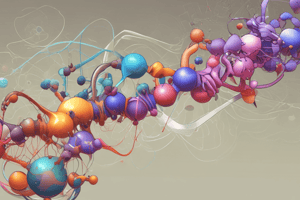Podcast
Questions and Answers
The induced-fit model, conformational-selection model, and a third model are the three common mechanisms of enzyme catalysis.
The induced-fit model, conformational-selection model, and a third model are the three common mechanisms of enzyme catalysis.
False (B)
Covalent catalysis occurs when multiple amino acids in the active site form a covalent bond with the substrate.
Covalent catalysis occurs when multiple amino acids in the active site form a covalent bond with the substrate.
True (A)
In general acid-base catalysis, water can be the only proton donor or acceptor.
In general acid-base catalysis, water can be the only proton donor or acceptor.
False (B)
Only one catalytic strategy is used by enzymes to catalyze reactions.
Only one catalytic strategy is used by enzymes to catalyze reactions.
Catalysis by approximation occurs when a single substrate binds to the active site to form the enzyme-substrate complex.
Catalysis by approximation occurs when a single substrate binds to the active site to form the enzyme-substrate complex.
Covalent catalysis involves the formation of a permanent covalent bond between the enzyme and substrate.
Covalent catalysis involves the formation of a permanent covalent bond between the enzyme and substrate.
General acid-base catalysis can only occur in the absence of water.
General acid-base catalysis can only occur in the absence of water.
The lock-and-key model, induced-fit model, and conformational-selection model are different mechanisms of covalent catalysis.
The lock-and-key model, induced-fit model, and conformational-selection model are different mechanisms of covalent catalysis.
The lock and key model proposes that the shape and chemistry of the substrate are identical to the shape and chemistry of the active site on the enzyme.
The lock and key model proposes that the shape and chemistry of the substrate are identical to the shape and chemistry of the active site on the enzyme.
There are five main categories of enzymes.
There are five main categories of enzymes.
Oxidoreductases catalyze the hydrolysis of a bond.
Oxidoreductases catalyze the hydrolysis of a bond.
Transferases catalyze the breakage of bonds without catalysis.
Transferases catalyze the breakage of bonds without catalysis.
Isomerases catalyze the association of two molecules.
Isomerases catalyze the association of two molecules.
Ligases catalyze the conversion of glucose-1-phosphate to glucose-6-phosphate.
Ligases catalyze the conversion of glucose-1-phosphate to glucose-6-phosphate.
Hydrolases catalyze the oxidation of pyruvate to acetyl coenzyme A.
Hydrolases catalyze the oxidation of pyruvate to acetyl coenzyme A.
The active site takes up a relatively large part of the entire enzyme.
The active site takes up a relatively large part of the entire enzyme.
In metal ion catalysis, the metal ion acts as a nucleophile to attack the substrate.
In metal ion catalysis, the metal ion acts as a nucleophile to attack the substrate.
Cooperativity between subunits always leads to increased substrate binding and enzyme activity.
Cooperativity between subunits always leads to increased substrate binding and enzyme activity.
The T-state of an enzyme has higher affinity for substrate binding than the R-state.
The T-state of an enzyme has higher affinity for substrate binding than the R-state.
In the concerted model, the transition from one state to another occurs sequentially.
In the concerted model, the transition from one state to another occurs sequentially.
Allosteric modulation is a type of catalysis that involves metal ions.
Allosteric modulation is a type of catalysis that involves metal ions.
The sequential model is a reversible model of allosteric modulation.
The sequential model is a reversible model of allosteric modulation.
Enzymes can only be composed of a single subunit.
Enzymes can only be composed of a single subunit.
Cooperativity is a mechanism that occurs only in single-subunit enzymes.
Cooperativity is a mechanism that occurs only in single-subunit enzymes.
Flashcards are hidden until you start studying
Study Notes
Mechanism of Enzyme Catalytic Strategies
- There are four common mechanisms by which enzymes alter the active site to create the enzyme-substrate complex: covalent catalysis, general acid-base catalysis, catalysis by approximation, and metal ion catalysis.
Covalent Catalysis
- Occurs when one or multiple amino acids in the active site transiently form a covalent bond with the substrate.
- Forms an intermediate through a nucleophilic attack of the catalytic residues, which helps stabilize later transition states.
General Acid-Base Catalysis
- Takes place when a molecule other than water acts as a proton donor or acceptor.
- Water can be one of the proton donors or acceptors in the reaction, but it cannot be the only one.
- Amino acid side chains can act as general proton donors and acceptors in the active site of an enzyme.
Catalysis by Approximation
- Happens when two different substrates work together in the active site to form the enzyme-substrate complex.
- A common example involves water entering the active site to donate or receive a proton after a substrate has already bound.
Metal Ion Catalysis
- Involves the participation of a metal ion at the active site of the enzyme.
- Helps make the attacking residue a better nucleophile and stabilize any negative charge in the active site.
Allosteric Modulation
- Enzymes can be either a single subunit or comprised of multiple subunits.
- The subunits in a multisubunit enzyme can work together in a mechanism called cooperativity, which can either boost or inhibit enzyme activity.
Cooperativity
- Can result in either a T-state (tense state) or an R-state (relaxed state) of the enzyme.
- T-state has less affinity for binding substrate, while R-state has higher affinity and increased substrate binding.
Two-State Allosteric Model
- The concerted model states that when an enzyme is in the T-state, if one subunit changes to the R-state, then all of the other subunits will change to the R-state at the same time.
- The sequential model states that once one effector binds to one of the subunits, the rest of the subunit's affinity for the effector increases, but they all do not necessarily change from one state to the other.
Classification of Enzymes
- According to the International Union of Biochemists (IUB), enzymes are divided into six functional classes based on the type of reaction they catalyze.
- The six kinds of enzymes are: hydrolases, oxidoreductases, lyases, transferases, ligases, and isomerases.
Types of Enzymes
- Oxidoreductases: catalyze oxidation and reduction reactions.
- Transferases: catalyze the transfer of a chemical group from one to another compound.
- Hydrolases: catalyze the hydrolysis of a bond.
- Lyases: catalyze the breakage of bonds without catalysis.
- Isomerases: catalyze the formation of an isomer of a compound.
- Ligases: catalyze the association of two molecules.
The Role of the Active Site
- There are three different models of substrate binding to the active site of an enzyme: the lock and key model, the induced-fit model, and the conformational-selection model.
- The lock and key model proposes that the shape and chemistry of the substrate are complementary to the shape and chemistry of the active site on the enzyme.
Studying That Suits You
Use AI to generate personalized quizzes and flashcards to suit your learning preferences.





